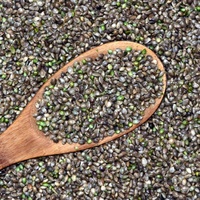Common name: Hemp
Other common names: Cannabis, Ganja, Marijuana
Description
Cannabis is a fast-growing, annual herb native to Central Asia, widely known for its many industrial and medicinal uses. It typically grows as a tall, slender plant, reaching heights of 3 to 5 meters (10 to 16 feet). The plant has narrow leaves with serrated edges and produces small, greenish, and inconspicuous flowers. Cannabis sativa is commonly dioecious, meaning male and female flowers are found on separate plants. However, monoecious varieties, which produce both male and female flowers on the same plant, are also cultivated for uniform growth.
Use
Industrial: Cannabis sativa is primarily valued for its strong and durable fibres, which are used to produce textiles, ropes, and paper. The seeds contain up to 35% oil, which is used in food products, cosmetics, and industrial applications such as paints and varnishes. Additionally, the seeds are rich in omega-3 fatty acids and are consumed as a health supplement. Cannabis fibres are also being explored as a sustainable material for bio-composites and eco-friendly packaging.
Medicinal: The plant has been used for centuries in traditional medicine, particularly for its pain-relieving and anti-inflammatory properties. Its active compounds, especially cannabinoids like THC and CBD, are widely used in modern medical treatments for conditions such as chronic pain, epilepsy, and multiple sclerosis. It is also used to alleviate symptoms of anxiety, insomnia, and nausea.
Recreational: The psychoactive compound THC, present in the resinous flowers of the female plant, is responsible for the recreational use of Cannabis sativa as marijuana.
Climate
Cannabis sativa is highly adaptable and can be cultivated in a range of climates, from temperate to tropical regions. It thrives in areas with full sun exposure and prefers moderate to high rainfall, ideally between 1200 and 3000 mm annually. Temperate climates are particularly well-suited for cultivating Cannabis sativa for fibre production, while tropical and subtropical regions are often used for seed and resin production. The plant is intolerant of extreme drought and waterlogged conditions.
Growing
Cannabis sativa is typically propagated from seeds and grows best in well-drained soils with adequate moisture. It requires full sunlight and benefits from rich, loamy soil with a slightly acidic to neutral pH (6.0-7.0). In intensive cultivation systems, monoecious varieties are preferred for uniform growth, especially when producing fibre. Proper water management is essential, as the plant does not tolerate either drought or excessive moisture. The growing season typically lasts between 4 to 6 months, depending on the local climate and the intended use of the crop.
Problem features
Cannabis sativa is considered an invasive species in some regions, particularly in areas where its rapid growth and tendency to spread can lead to environmental disruption. In Hawaii, for example, the Hawaii Pacific Weed Risk Assessment project has classified it as a high-risk weed. Additionally, due to its psychoactive properties, the cultivation of Cannabis sativa is highly regulated in many countries, with strict laws governing its production, distribution, and use.






